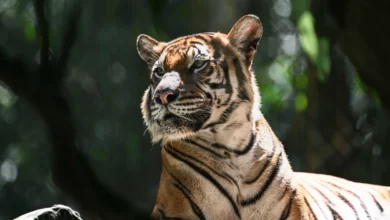
The fate of a species may just rest on this love story.
Happily, the first date between Romeo, once the last-known Sehuencas water frog, and Juliet, who was discovered deep inside a Bolivian cloud forest in January, went so well the two have been living together in the male’s aquarium since.
According to a statement by Global Wildlife Conservation (GWC) on Monday, the pair were introduced on March 1 after being cleared of chytridiomycosis, which has decimated amphibian populations throughout the Neotropics region.
After a period of observation, they were moved into Romeo’s aquarium, where he made a mating call for the first time since 2017: a clear sign he is eager to breed.
“Romeo has been really sweet to Juliet, following her around the aquarium and sacrificing his worm meals for her,” said Teresa Camacho Badani, chief of herpetology at the Museo de Historia Natural Alcide d’Orbigny in Bolivia, which is working on the project with the GWC.
“After he’s been alone for so long, it’s wonderful to see him with a mate finally.”
Romeo had been found in the same cloud forest a decade ago and it was feared that he was the last survivor of his species.
With a lifespan of 15 years, time was running out to find Romeo a mate to ensure the survival of the species, although the frog himself never gave up hope, continuing to call out for a mate during his decade in captivity.
Twinkle-toed performance
But it’s not quite happily ever after, at least not yet.
Romeo hasn’t fully figured out amplexus — the mating position for frogs where the male holds the female until he can fertilize her eggs as she lays them.
Some species of frog need to go into amplexus for weeks or even months, but it isn’t known how long it lasts for the Sehuencas.
So far Romeo has gotten into the correct position a handful of times — the longest for about 15 minutes on the first day the two were put together.
Since meeting Juliet, Romeo has also exhibited a behavior water frog experts had not encountered for this species: a performance in which he rapidly twinkles the toes of his back feet, likely intended to impress the female.
Apart from Juliet, four other Sehuencas water frogs were brought in from the wild during the same expedition: two males and two additional females.
They were the first Sehuencas frogs that researchers had seen in the wild in a decade. The others have just begun showing signs of being ready to breed, and remain together in a single aquarium.
According to the GWC, Bolivia has the 10th highest level of amphibian diversity in the world, but 22 percent of those species now face the threat of extinction.
The Sehuencas frog, which is completely aquatic, was once found in abundance at the bottom of small streams and rivers or in ponds deep inside mountain forests.
A combination of climate change, habitat destruction, contamination, chytridiomycosis and the introduction of invasive trout provoked the abrupt demise of many aquatic frog species in Bolivia, Ecuador and Peru.




